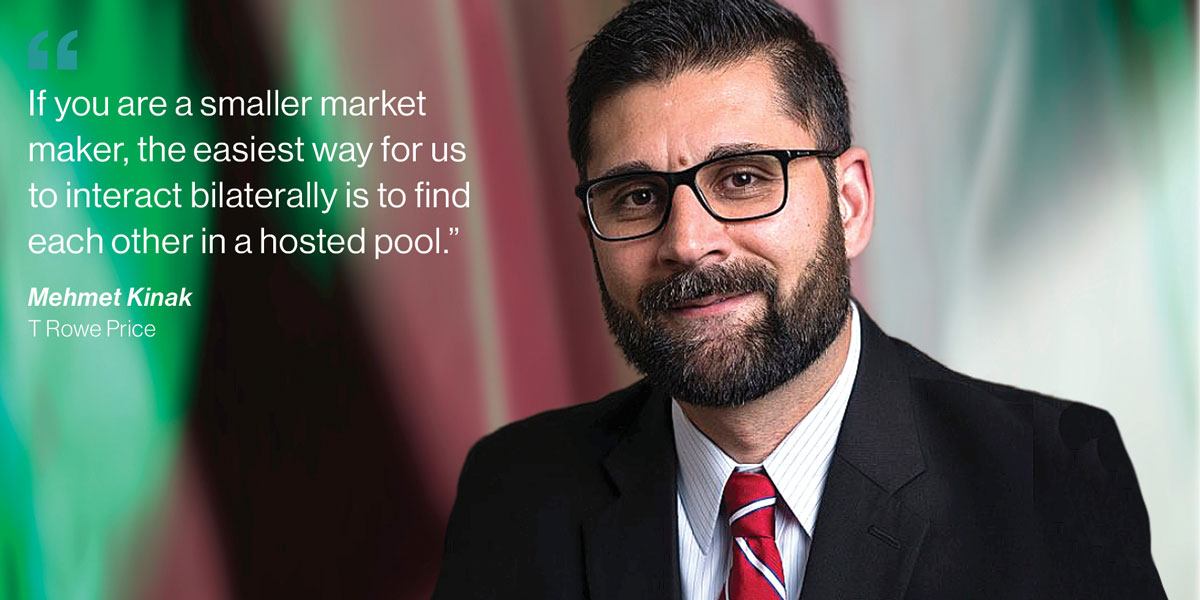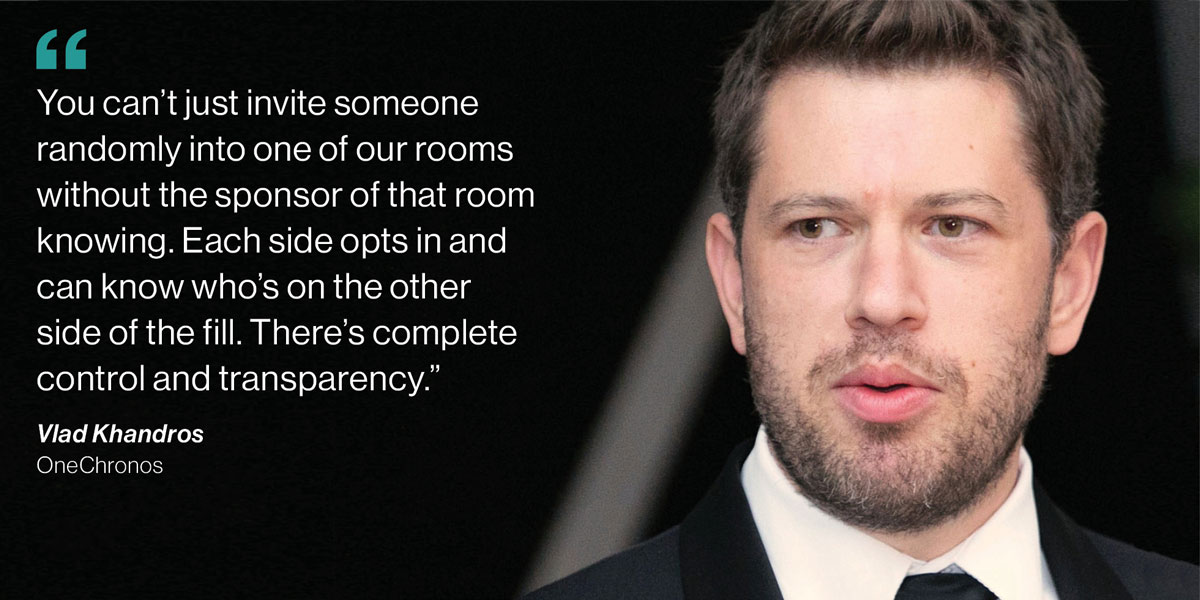The use of alternative trading systems (ATSs) has increased drastically over recent years, now accounting for more than half of US equity trading volume. Lately, these platforms have begun to offer a new service, allowing brokers to create closed trading pools for their buy-side clients. These private rooms – also called hosted rooms – allow brokers to internalise their flows without having to create their own dark pools and go through the burdensome technical and regulatory workload this would provoke.
These venues also minimise the market impact of larger trades, with prices remaining steadier than they would on a lit venue.
It all sounds appealing – until you hear whispers that these rooms are not as private as they seem, and that market makers are being let in on the sly to snap up order flow.
Reports of this nature have been swirling for a number of years now, popping up at conference panels and in quiet conversations – although there is hesitancy among individuals to be too vocal about their concerns. For some, this has given private rooms a sordid edge, the platforms looked down on as illegitimate intruders.
Global Trading spoke to buy-side participants to get to the root of the rumours.
Pool party
Mehmet Kinak, global head of equity trading at T Rowe Price, explained how private rooms are filling a gap in the market. “If you run an ATS, I can interact with your liquidity in that dark pool. If you run a single dealer platform, I can interact with you there. But if you are a smaller market maker that has neither of those options, we have nowhere to meet up bilaterally. The easiest solution for us to be able to interact bilaterally is to find each other in a hosted pool,” he said.
Market makers are attracted to private rooms because of their perennial fear of adverse selection in public venues by participants possessing market-moving information. “When trading on exchange, flow is an aggregate of many different market participants with both benign (non-directional) flow and directional flow,” according to Jeremy Smart, Head of Distribution at XTX Markets. “As a result, market makers will provide liquidity that reflects the average of the flow profile. Because of this, the benign flow does not attract the liquidity that it could achieve.

“If a client has really good flow, it makes sense to go to a hosted room to get some of the best, highest quality liquidity,” Smart adds. “They allow for interactions on a more bespoke basis, without the need to connect to 10 different liquidity providers and for 10 different FIX connections.
“It’s more direct, more disclosed, and can facilitate really strong direct relationships.”
“Because you know who the other parties are, you can show even larger sizes and or even better pricing,” explained Vlad Khandros, CEO of OneChronos Capital Markets, referencing the company’s Nexus platform. “That can increase the liquidity in the pool and provide better pricing. If people know who they’re trading with, they can further lean in.”
There’s a reduced risk of information leakage when private rooms are used, an appealing prospect for buy-side traders desperate to avoid competitors frontrunning them. A limited number of counterparties cuts down the chance of information revealed, deliberately or inadvertently, being used against room participants, allowing them to be bolder in their actions.
“Clients have the ability to completely control how the room works, the prioritisation of who gets the orders first before random allocation – however they want the logic to work, they can set it up,” Smart added.

“Whether you’re a retail broker or a long-only buy-side trader or a systematic hedge fund, it doesn’t matter. Whatever type of client you are, you’re in complete control of who is in the pool, the attributes of the pool and ultimately therefore the liquidity you can access.”
The private room concept is not exclusive to ATSs, according to Kinak. “Single-dealer platforms like Virtu and Citadel are running similar services,” he said. “They wouldn’t call themselves hosted rooms because they have their own venues, but they are essentially doing the same thing, just operating the venue itself.”
Those names have cast a shadow over the space, with rumours that the market makers are being let into hosted rooms and nabbing flow without the knowledge of other participants.
Uninvited guests
Providers, of course, are keen to dispute the claims, defending the security of their systems and the resilience of their compliance.
“You can’t just invite someone randomly into one of our rooms without the sponsor of that room knowing,” Khandros said. “Each side opts in and can know who’s on the other side of the fill. There’s complete control and transparency. We’ve built it with the customer in mind. Giving our customers the option of that full control, we think, is a good thing.”

Among other market participants, those with less skin in the game, the sentiment is similar. Smart is direct: “The rumours are complete fantasy. There’s no lack of transparency there – the client is in full control.”
“These ideas are being pushed by those who want interactions to happen on their terms,” he argued, noting a historical trend of suspicion towards any changes in market structure.
“We’ve heard some negativity from people who wanted to launch a platform and didn’t, or who aren’t being invited to these rooms,” a source familiar with the issue corroborated.
“Conspiracy theories are always running rampant in our industry,” Kinak agreed. “Traders are generally sceptical around how things work. They’re paranoid.”
However, he acknowledges that there is a kernel of truth in some of these concerns.
“It’s true that private rooms are not as transparent as the lit market. Segmentation, by definition, is going to limit people’s participation. But that’s one of the main reasons we use ATSs,” Kinak said.
“I try to dispel the negative connotations around private rooms,” he added. “Lots of people think mysterious things are going on in them, but they’re just a solution to help with segmentation.”
Worries about who else is in a private room are not without precedent.
“When the national market system (NMS) regulation was introduced in the US, there were a couple of scandals about players allowing people into their dark pools without disclosure,” one market participant recalled. “Sometimes it was market makers, sometimes principal flow from their own shops. They were fined and suffered reputational damage.”
“I can’t imagine anyone doing something like that now. It’s so baked in that you have to be clear about how your platform operates,” they mused – but fears of a potential recurrence are high.
“People are concerned whether they can genuinely know who the counterpart is in that hosted room. And the thing is, you don’t know,” Kinak observed. “You have to believe that the venue operating the hosted room is doing things appropriately and legally.”
While that might make the prospect of a private room seem more risky, it’s no different from the situation in any ATS or dark pool. “I find it funny that there’s this narrative of deception in private rooms, because it can happen anywhere. You just have to trust the operator,” Kinak observed. “If I go to the largest ATS, request to only interact with a particular group of market participants, and they tell me they’ve codified it that way, I just have to believe them. There’s no way to verify what they’re telling me.”
Clearer waters
As such, uncertainties around private rooms are fuelling a wider conversation – ATS regulation as a whole. Currently, in the US, ATSs are obliged to report all trades and orders to FINRA under the CAT regulation. CAT was designed to prevent manipulative trading strategies and tactics, Mark Davies, CEO and co-founder of S3, explained, seeking to provide a clearer, more transparent picture of the market after the 2010 flash crash.
The number of shares executed must be disclosed, but not where or who with. As such, the broker actually doing the trade can remain anonymous – and may be far more present in a certain stock or market than they appear to be. This has been used as a reason to illegitimise private rooms, driving concerns that if market giants are sneaking into private rooms, they could be eating up much more of the pie than it seems.

However, this is part of broader ATS regulation rather than the small private room subsection – regulation that many players have less issue with when it comes to dark pools.
Platforms are also subject to Rule 605 and 606. The former, an order execution quality requirement, is receiving an ATS-specific update at the end of 2025. “Previously a firm like UBS didn’t have to separate out their ATS flow from their main broker dealer flow or their STP flow. Now that has to be reported independently, and there are quite a few more statistics than there used to be,” Davies explained.
Rule 606 obliges brokers to disclose where orders are routed to. This is a hazy area for ATSs, Davies said. “An ATS is generally considered a terminal venue for 606 purposes, which means it executes and therefore they don’t have any onward routing that needs to be reported.
“However, a lot of the ATSs have routers that they run in tandem. If an order is sent to an ATS or private room as an execution venue via a router, then the firm would have to disclose that. The ATS, in turn, would not have to disclose any onward routing.”
When ATS trades are reported, it is not specified where the execution took place. It may have been completed in a dark pool, via trajectory crossing or in a private room – no one, aside from those taking part in the trade, can say for sure. This is one of the transparency hangups people have with hosted rooms and ATSs as a whole, arguing that the non-granular reporting practices are wilfully opaque.
With all the furore around private rooms, it could easily be assumed that they are taking a significant chunk of the flow. That’s the opposite of the case, according to the IntelligentCross spokesperson. “It’s a single digit percentage of our overall volume,” she said, while Kinak cited a less than 10% figure for the amount of ATS flow going through private rooms.
“It’s not significant, but they’re willing to be transparent about it,” he said.
Under the SEC’s ATS-N filing requirements, providers do not have to answer questions about private rooms they provide. The number of rooms on offer, the counterparties involved, fees, and volumes can remain under wraps.
“Transparency around their size, their meaningfulness, is valuable,” Kinak said. “If people can see that an ATS has 2% of total market share, and that 2% of that share is in hosted rooms, they’d realise that there’s no big story. On the other hand, if half of that market share is made up of private room volumes, that changes the narrative. People generally want to concentrate their orders in venues where liquidity is accessible.”
Whether ATSs and private rooms should be more regulated and transparent is a contentious issue. Some argue that more transparency is always a good thing. “I absolutely support additional transparency and regulation around how private rooms are operated,” Kinak asserted, “and I don’t think anyone would be opposed to that. Both the venue operator and the person hosting the specific room would be happy to provide transparency, because they’re not doing anything sinister. They’re hosting the room so they can interact with certain people or a specific segment of the market.”
Others, though, don’t see it the same way, arguing that greater disclosure demands would go against the point of the format. “We can’t necessarily see where flow is coming from,” one person familiar with the subject said, “but that’s by design – we’re not supposed to know. The breakdowns within individual pools are in the hands of the subscribers, not us. People are looking for data on this, on things like retail versus institutional participation, but that’s not consistent or available.”
This is not an opacity issue, the IntelligentCross spokesperson asserts. “Hosted rooms are another tool in the trader’s toolbox in their efforts to access liquidity but not move the market.”
Smart does not see the need for anything to change. “ATSs are perfectly within their rights to create segmented pools of liquidity. Hosted rooms exist in plain sight, in a regulated environment,” he said.
Building trust
Although the amped-up rumours about private rooms are unfounded, they point to a wider demand for transparency – and a lack of trust in the industry. While some are calling for the introduction of new or more comprehensive regulation across alternative trading systems, it is likely that any changes will be put on ice for now.
“Realistically, I don’t think we’re going to see a lot of new regulations in the next four years,” Davies commented. “We’re more likely to see a reduction, particularly in restrictive regulation.”
As market participants continue to seek out alternatives to the lit market, new ways to avoid information leakage and access to the best liquidity available to them, the emergence and popularity of systems like private rooms will inevitably grow. Whether the industry will learn from past mistakes, keep a close eye on platform regulation and play nice is less certain.
It’s a thorny issue, but one thing’s for sure: don’t believe every rumour you hear on the street.

